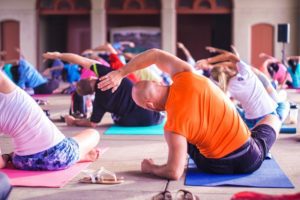Who is a member?
Our members are the local governments of Massachusetts and their elected and appointed leadership.

Wellness programs, which can include yoga and other exercise classes, can benefit municipalities and their employees.
“Management is doing things right; leadership is doing the right things.”
– Management expert Peter Drucker
In recent interviews, wellness experts and town human resources and health leaders agree that offering a wellness program for municipal employees falls in the category of doing the right thing.
But not all wellness programs are created equal, according to Al Lewis, cofounder and CEO of Quizzify, whose mission is to create health-literate employees. He says wellness programs fall into two categories: those done to employees and those for employees.
Pry, poke and prod vs. well-being
Wellness programs that begin with all sorts of expensive tests to measure cardiac efficiency and blood sugar levels, or involve measurements such as BMI and weight and delve into detailed medical histories fall in the category of programs done to employees — what Lewis calls Pry, Poke and Prod Programs.
“Over-screening and sending people for extra tests does not improve their wellness,” Lewis said. “Both the National Bureau of Economic Research and work done by a team of Harvard and University of Chicago researchers show there is zero risk reduction and no cost savings for employees or employers who engage in PPP-type programs.”
If your idea of a wellness program is measurement via a “PPP” program, with the primary goals being return on investment and dollar savings, he warns, your wellness program will not be effective. Instead, he suggests that overall well-being be the primary goal.
Enter wellness programs that are for employees.
“Wellness programs should help employees feel valued and supported,” said Courtney Hernandez, MIIA’s wellness program manager. “With MIIA’s wellness programs, we help people start with small changes that help them get healthier and feel better about themselves. And if people are healthier and happier, chances are they are more productive at work.”
Wellness working locally
Sandwich Human Resources Director Marie Buckner, who spearheads the wellness program for the town and its schools, said the program “is like a bonus for employees.” She said employees have also learned there is a lot more to wellness than riding a bike or taking a walk.
“From the in-person yoga classes to the online diabetes groups and nutrition classes, to learning how to save money by being smart health care shoppers, it all helps employees feel valued,” Buckner said. “And there is a program for every skill and energy level, so everyone can participate.”
Melissa Ranieri, the health director who heads the wellness program for the town of Walpole, said the program gets positive feedback from employees.
“People love it,” she said. “They tell me how grateful they are for the opportunity to participate.”
Walpole’s wellness program offers many benefits to employees, including improving morale and building camaraderie among employees across diverse departments, she said. Wellness becomes part of who the employees are.
“These aren’t just one-and-done programs,” Ranieri said. “People are transformed and make wellness part of their lifestyle.”
Keys to success
Hernandez identified three key steps to creating a wellness program, and three rules to follow. Support from the top is number one.
“A simple, positive memo to all employees from the town manager, mayor, and/or department heads announcing the wellness program and encouraging them to participate is the way to start,” she said.
Next, make a bigger commitment by building a wellness committee that includes members from across all municipal departments.
Step three is to appoint a wellness champion, whose job description includes promoting and organizing the wellness programs and taking feedback from employees.
When implementing a wellness program, Hernandez said, the first rule is to ensure that all employees can participate — not just subscribers to the health care plan that might be implementing the program. Second, is to offer a wide range of programs across all exercise levels. Include mental as well as physical health options, and add cooking and nutrition classes.
A combination of online and in-person activities gives people more options to incorporate wellness activities on a schedule that works best for them, Hernandez said.
Finally, she said, always use qualified and certified instructors.
Many successful programs start by offering incentives to encourage participation.
“Low-cost items such as a water bottle, beach towel or gift card can be the motivation that sets a person on their wellness journey,” Hernandez said. “But once they’re in, they’re hooked, and they come back for more. The wellness itself becomes intrinsic and carries throughout their work and home lives, improving their overall well-being.”
And this, she noted, was the goal from the start.
Written by Joyce McMahon, freelance writer